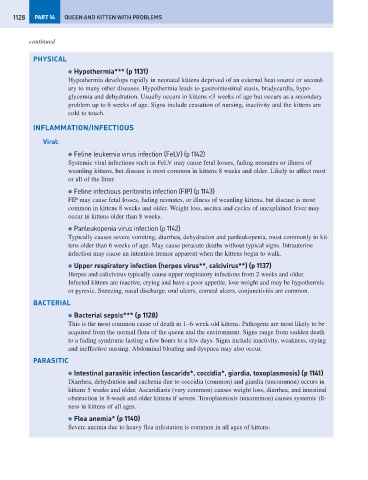Page 1136 - Problem-Based Feline Medicine
P. 1136
1128 PART 14 QUEEN AND KITTEN WITH PROBLEMS
continued
PHYSICAL
● Hypothermia*** (p 1131)
Hypothermia develops rapidly in neonatal kittens deprived of an external heat source or second-
ary to many other diseases. Hypothermia leads to gastrointestinal stasis, bradycardia, hypo-
glycemia and dehydration. Usually occurs in kittens <3 weeks of age but occurs as a secondary
problem up to 6 weeks of age. Signs include cessation of nursing, inactivity and the kittens are
cold to touch.
INFLAMMATION/INFECTIOUS
Viral:
● Feline leukemia virus infection (FeLV) (p 1142)
Systemic viral infections such as FeLV may cause fetal losses, fading neonates or illness of
weanling kittens, but disease is most common in kittens 8 weeks and older. Likely to affect most
or all of the litter.
● Feline infectious peritonitis infection (FIP) (p 1143)
FIP may cause fetal losses, fading neonates, or illness of weanling kittens, but disease is most
common in kittens 8 weeks and older. Weight loss, ascites and cycles of unexplained fever may
occur in kittens older than 8 weeks.
● Panleukopenia virus infection (p 1142)
Typically causes severe vomiting, diarrhea, dehydration and panleukopenia, most commonly in kit-
tens older than 6 weeks of age. May cause peracute deaths without typical signs. Intrauterine
infection may cause an intention tremor apparent when the kittens begin to walk.
● Upper respiratory infection (herpes virus**, calcivirus**) (p 1137)
Herpes and calicivirus typically cause upper respiratory infections from 2 weeks and older.
Infected kittens are inactive, crying and have a poor appetite, lose weight and may be hypothermic
or pyrexic. Sneezing, nasal discharge, oral ulcers, corneal ulcers, conjunctivitis are common.
BACTERIAL
● Bacterial sepsis*** (p 1128)
This is the most common cause of death in 1–6-week-old kittens. Pathogens are most likely to be
acquired from the normal flora of the queen and the environment. Signs range from sudden death
to a fading syndrome lasting a few hours to a few days. Signs include inactivity, weakness, crying
and ineffective nursing. Abdominal bloating and dyspnea may also occur.
PARASITIC
● Intestinal parasitic infection (ascarids*, coccidia*, giardia, toxoplasmosis) (p 1141)
Diarrhea, dehydration and cachexia due to coccidia (common) and giardia (uncommon) occurs in
kittens 5 weeks and older. Ascaridiasis (very common) causes weight loss, diarrhea, and intestinal
obstruction in 8-week and older kittens if severe. Toxoplasmosis (uncommon) causes systemic ill-
ness in kittens of all ages.
● Flea anemia* (p 1140)
Severe anemia due to heavy flea infestation is common in all ages of kittens.

